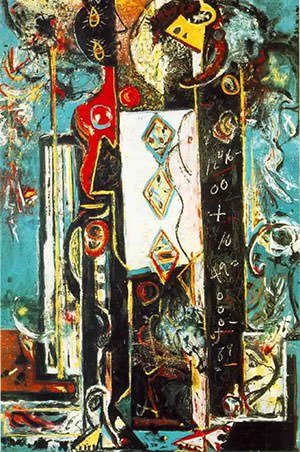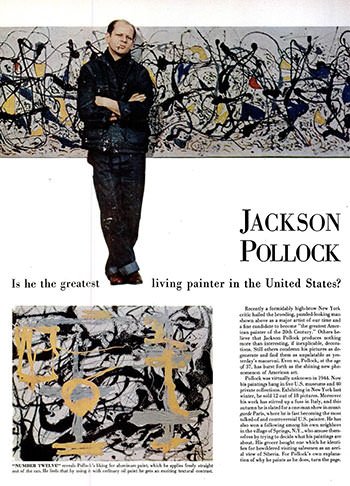Jackson Pollock was an American painter who is widely regarded as one of the greatest artists of the 20th century. The youngest of five sons of LeRoy Pollock and his wife Stella May, Pollock followed his two elder brothers into the art world. He faced financial difficulties in his early career and there was a point when he was so poor that he had to work as a janitor and steal food to survive. Pollock met his future wife Lee Krasner in 1942, and through her support, he began making a mark as an artist. Pollock developed his trademark style of Drip painting in the late 1940s becoming one of the most renowned artists in the United States. Pollock had a lifelong issue with alcohol and while driving his car under the influence of alcohol he met with an accident which led to his death. Know more about the family, life, childhood, education, marriage, artistic career and death of Jackson Pollock through his biography.
Family And Childhood
Born on January 28, 1912 in Cody, Wyoming, U.S., Paul Jackson Pollock was the youngest of five sons of LeRoy Pollock and his wife Stella May. Both his parents were of Scotch-Irish descent. His father was born with the surname McCoy but later took the surname Pollock of his neighbors, who adopted him after his own parents died. LeRoy Pollock was initially a farmer and later went on to become a land surveyor for the government while Stella May sold dresses as a teenager.

When Jackson was 10 months old, his family left Cody, Wyoming and he subsequently grew up in Arizona and California over the next 16 years. During this time, his family moved a total number of 9 times. In 1920, when Jackson was 9 years old, his father separated from the family. He, however, maintained contact through letters and visited on holidays.
Education
In 1923, Jackson enrolled in the sixth grade of Monroe Elementary School, in Phoenix, Arizona. However, the following year, the family moved to Riverside, California. In 1926, Jackson graduated from the Grant Elementary School in Riverside. The following year, he enrolled at the Riverside High School. Here, he joined the Reserve Officers’ Training Corps (ROTC) program. Although, Jackson was only 15 at the time, he started drinking heavily. While drunk, he punched a student during an ROTC parade drill and he was consequently expelled from the ROTC.

On September 11, 1928, Jackson enrolled at the Manual Arts High School in Los Angeles where he came under the influence of Frederick John de St. Vrain Schwankovsky. Through him, Pollock picked up on some rudimentary training in drawing and painting and grasped the nuances of European modern art. However, in March 1929, Jackson was expelled from Manual Arts High School for disciplinary reasons.
Two of Pollock’s elder brothers, Charles and Sanford, also pursued careers as artists. In fact his eldest brother, Charles Pollock went on to became a renowned abstract painter. In September 1930, Jackson followed Charles to New York City. Here, along with his brother, Jackson joined the Art Students League on West 57th Street. Both Charles and Jackson studied under Thomas Hart Benton. For the next two and a half years, Jackson actively studied everything about life drawing, painting and sculpture. Furthermore, he picked up the concepts of the rhythmic use of paint.
Early Career
In 1933, Pollock left the Art Students League. During most of the 1930s and the early 1940s, Pollock lived with his brothers Charles and Sanford. He had to face much economic difficulties and at times he was so poor that he had to work as a janitor and steal food to survive.
In 1936, Pollock attended an experimental workshop of famous Mexican muralist David Alfaro Siqueiros in New York City where he was introduced to the use of liquid paints. This had a significant effect in developing Pollock’s style of painting since he would later use paint pouring as a prominent technique in his canvases of the early 1940s, such as Male and Female and Composition with Pouring I.

In the years from 1938 to 1942, he worked for the Works Progress Administration’s Federal Art Project, a government program to fund the visual arts in the United States. This was also the time when Pollock started struggling with alcoholism. As a result, he underwent Jungian psychotherapy with doctor Joseph Anderson from 1938 to 1941 and Doctor Violet Staub de Laszlo in 1941–42. Among other things, during the psychotherapy, he was encouraged to express Jungian concept and archetypes through his paintings.
Marriage
In 1942, after their brief meting in 1936, Jackson Pollock again met Lee Krasner, an American abstract expressionist painter. This meeting was a turning point in Pollock’s career as Krasner began supporting and promoting his work. Also, Krasner had considerable influence on Pollock’s work since her extensive knowledge and training in modern art and techniques exposed Pollock to the intricacies of contemporary art. This helped Pollock to tweak his style of painting, making it more organized.

Pollock and Krasner became romantically soon after their meeting in 1942. In 1945, they bought an old farmhouse in the town of The Springs on Long Island and moved there together. This gave a good opportunity to the couple to focus on their art in the seclusion and peace away from the city. On October 25, 1945, Jackson Pollock and Lee Krasner got married at the Marble Collegiate Church in New York in the presence of two witnesses.
Breakthrough And Fame
In July 1943, Pollock signed a gallery contract with wealthy American art art collector Peggy Guggenheim. According to the contract, he would receive a commission to create a Mural for the entry to her new townhouse. Pollock’s friend Marcel Duchamp advised him to paint the work on canvas instead of the wall to make it portable. The result was extremely well received in the artistic world, with a leading art critic of the time, Clement Greenberg, writing a review about it: “I took one look at it and I thought, ‘now that’s great art’ and I knew Jackson was the greatest painter this country had produced”.

In the mid-1940s, Pollock started to get rid of the symbolic imagery in his paintings and looked for more abstract means of expression. He then arrived at the method for which he is most renowned, the Drip Technique. Drip painting is a form of abstract art in which paint is dripped or poured onto the canvas, rather than being carefully applied. Pollock was the pioneer of the drip technique due to which the TIME magazine dubbed him as “Jack the Dripper”.

The period of Pollock’s career between 1947 and 1950 is popularly referred to as the Drip Period. He painted his most famous works during this time that skyrocketed him to fame. On August 8, 1949, Life magazine published an article which asked the question, “Is he (Pollock) the greatest living painter in the United States?” However, while he was at the peak of his fame, Pollock made the decision of dropping the drip style altogether. His subsequent works were darker in color and are referred to as the “Black Pourings”. This was Pollock’s attempts to strike a balance between abstraction and depictions of the figure. Later, he returned to using colors along with figurative elements.
Death And Legacy
By 1954, Pollock claimed that he had nothing left to say through his art and consequently he painted little. Moreover, he again began to struggle with alcoholism. In the summer of 1956, Krasner took a trip to Europe to get some distance from Pollock. This was followed by Pollock beginning an affair with Ruth Kligman, a 25-year-old artist. On August 11, 1956, at 10:15 pm, Jackson Pollock died in a car crash while driving under the influence of alcohol. He was 44 years old. His co-passengers were Kligman and her friend, Edith Metzger. Metzger also perished in the crash while Kligman suffered from serious injuries.

Following Pollock’s death, his widow Lee Krasner went on to manage his entire estate. She also tried her best to make sure that Pollock’s reputation remained untainted in the midst of an ever-changing backdrop of the artistic world. Today, the couple are buried together at the Green River Cemetery in Springs. Since Pollock’s death, a number of exhibitions have been organized to display his work. His reputation has enhanced with time. Today he is considered as an iconic master of mid-20th century Modernism; and one of the greatest and most influential artists of his time.

